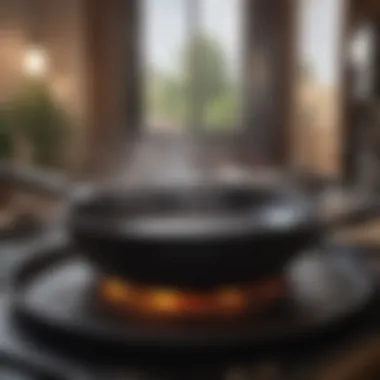Mastering Cast Iron: Cleaning and Seasoning Guide


Intro
Cast iron frying pans are treasured kitchen tools known for their durability and superb cooking capabilities. Proper maintenance can greatly extend their life and enhance their performance. This article aims to provide a thorough understanding of how to clean and season these pans, ensuring they remain your reliable cooking companion.
Feature Spotlight
Exceptional Care Techniques
Cleansing a cast iron frying pan is more than just rinsing it with water. It requires specific techniques to preserve the seasoning. While many assume soap is a big no-no, a little mild soap can be used occasionally without harming the seasoned layer. The process involves scraping off any stuck food particles while the pan is still warm.
Key Steps for Effective Cleaning:
- Heat the Pan: Warm the pan to loosen food remnants.
- Use a Scraper: Employ a spatula or a wooden spoon to scrape off stubborn bits.
- Rinse with Water: Rinse under hot water, using a non-metal brush or sponge.
- Dry Immediately: To prevent rusting, dry the pan thoroughly with a cloth or by placing it on low heat.
Unique Seasoning Method
Seasoning is a crucial process in maintaining a cast iron frying pan. This layer of oil polymerizes, creating a non-stick surface while also guarding against corrosion. A proper seasoning not only enhances the cooking surface but also adds flavor to your dishes.
Steps for Seasoning:
- Select Oil: Use oils with high smoke points, like flaxseed oil or grapeseed oil.
- Apply a Thin Layer: Using a paper towel, spread a thin coat on the entire surface of the pan.
- Heat it Up: Place the pan upside down in an oven at 350°F (175°C) for an hour. This allows the oil to bond with the metal.
- Cool Down: Let the pan cool in the oven.
A well-seasoned cast iron pan can last for generations if taken care of properly.
Epilogue
Cleansing and seasoning your cast iron frying pan are paramount tasks any cooking enthusiast should master. The process is not lengthy or overly complicated, yet the rewards are significant. Not only does it improve the lifespan of your frying pan, but it also preserves the quality of your meals. Through attentive care, your cast iron frying pan can become a cherished heirloom, delivering exceptional results long into the future.
Prelims to Cast Iron Frying Pans
Cast iron frying pans represent a crucial component in both culinary and kitchen maintenance discussions. Their unique properties and long-term usability make them a preferred choice for many cooks. Understanding these essential tools provides insight into their functionality and care strategies, allowing for successful culinary endeavors without the risk of damage.
Understanding the Material
Cast iron is an alloy of iron and carbon, known for its ability to retain and distribute heat evenly. This material has been utilized for centuries due to its durability and versatility. Unlike modern non-stick cookware, cast iron develops a natural non-stick surface when seasoned properly. This characteristic is often enhanced with usage, making each pan a personal investment over time.
In essence, a cast iron frying pan consists of a non-porous surface, which can withstand high temperatures. This feature allows for searing, frying, and baking, all in one vessel. Moreover, cast iron's ability to go from stovetop to oven is a testament to its versatility. Recognizing these properties is vital to appreciating the necessity of proper care and maintenance of the pan.
Benefits of Cast Iron Cookware
Using cast iron cookware offers numerous advantages. Firstly, it is affordable. When cared for appropriately, it can last several lifetimes. Many families pass down their seasoned cast iron pans through generations, creating a sentimental value alongside practical benefits.
Secondly, cast iron cookware provides health benefits. Cooking with cast iron can actually increase the iron content of food, especially acidic foods like tomato sauce, which helps in iron absorption.
In addition, cast iron's heat retention is exceptional. It can maintain heat for extended periods, leading to better cooking results, particularly for slow-cooked dishes.
Lastly, its versatility means it can be employed in a variety of cooking methods, from baking cornbread to frying chicken. The capacity to tackle multiple culinary tasks in a singular pan is appealing for those who prefer minimizing kitchen clutter. Understanding these benefits enables one to appreciate not only the practicality of the cast iron frying pan but also its value in the kitchen.
The Importance of Proper Care


Proper care of a cast iron frying pan is crucial for maintaining its performance and longevity. A well-cared-for pan not only provides superior cooking results but also enhances the overall experience in the kitchen. It can withstand high temperatures and distribute heat evenly, offering the versatility that many home cooks desire. When you take the time to care for your cast iron, you can enjoy these benefits for many years.
Impact on Cooking Performance
The cooking performance of a cast iron frying pan heavily relies on its condition. A seasoned pan offers a natural non-stick surface and retains heat effectively. When the surface is well-maintained, it allows foods to brown beautifully and prevents sticking. This is particularly vital for recipes where caramelization and browning are essential, such as when cooking meats or sautéing vegetables.
If the pan is neglected or improperly cared for, it can lose this non-stick quality. Food might stick, leading to uneven cooking. Maintaining the seasoning and keeping the surface clean ensures that every cooking session yields great results. By investing a little time in its care, you can achieve professional-level results at home.
Enhancing Longevity
A cast iron frying pan can last a lifetime if properly maintained. Proper care not only enhances its cooking performance but significantly extends the lifespan of the cookware. Regular cleaning, seasoning, and addressing any issues promptly help prevent deterioration. Cast iron is prone to rust if exposed to moisture or acidic foods without appropriate treatment.
"A well-seasoned cast iron frying pan can be handed down through generations."
In the long run, maintaining your cast iron frying pan saves you money, as you won’t need to replace it frequently. Instead of facing the costs of buying new cookware, you can invest that money elsewhere. The care you provide establishes a strong bond between you and your kitchen tool, allowing it to develop a history that improves with use.
To summarize, the importance of proper care cannot be understated. The result is not just a functional kitchen tool; it is an integral part of your cooking journey. By understanding how to care for your cast iron frying pan, you open the door to improved cooking experiences and longevity of this essential kitchen item.
Cleaning the Cast Iron Frying Pan
Cleaning a cast iron frying pan is a crucial part of its maintenance. Proper care ensures that the pan remains in optimal condition for cooking. Neglecting to clean it correctly can lead to rust, stuck-on food, and a decline in cooking performance. Thus, knowing the right methods and materials is essential. As this article will explain, a clean frying pan promotes better cooking results and extends the life of the cookware.
Immediate Care After Use
After using your cast iron frying pan, it’s important to handle it properly. Start by letting the pan cool down slightly but not completely. If you wash it while it's still warm, any stuck food will release more easily. Avoid letting the pan sit for too long with food residue. This can harden, making it tougher to clean later. Once you’ve finished cooking, carefully scrape out any bits of food using a spatula. This step minimizes residue and aids in the cleaning process.
Appropriate Cleaning Materials
Choosing the right cleaning materials is key to maintaining your cast iron frying pan. Traditional soap is generally not recommended. Instead, use coarse salt as a gentle abrasive if there’s stubborn residue. A stiff brush or a plastic scrubber will work well for cleaning. For more delicate cases, hot water alone can often suffice. Avoid metal scouring pads that can scratch the seasoning of the pan. It's also helpful to have some vegetable oil handy for seasoning after cleaning.
Steps to Clean Thoroughly
To achieve a thorough clean, follow these steps:
- Cool Down the Pan: After cooking, allow the pan to cool down slightly.
- Scrape Out Food: Use a spatula to remove leftover food.
- Add Cleaning Materials: Pour some hot water into the pan. If needed, sprinkle coarse salt for scrubbing.
- Scrub: Use the stiff brush or plastic scrubber to scrub off residue.
- Rinse: Rinse the pan with hot water, ensuring all food and salt are removed.
- Dry: Wipe the pan dry with a clean cloth immediately after rinsing to prevent rust.
- Re-season: If necessary, apply a thin layer of vegetable oil to maintain the seasoning.
Proper cleaning techniques preserve the quality of your cast iron frying pan. With consistent practice, you will enhance its longevity and cooking performance.
Dealing with Stubborn Residue
Cleaning and maintaining a cast iron frying pan requires attention to detail, especially when it comes to stubborn residue. This residue can accumulate from various sources such as food debris, grease, and burnt oils. Addressing this type of buildup is vital. It not only affects the appearance of your pan but also its cooking efficiency. Neglecting stubborn residue can lead to flavors transferring between dishes and a compromise in the quality of your cooking. Therefore, it is essential to tackle this issue head-on to preserve the integrity of the frying pan.
Using the Right Techniques
When confronting stubborn residue, the choice of technique can make a significant difference. Aim to avoid harsh chemicals or abrasive tools that can damage the seasoning. Instead, try these methods:
- Hot Water Soak: Fill the pan with hot water and let it soak for a while. This helps to loosen debris.
- Scraping: Utilize a non-abrasive spatula or a plastic scraper to gently lift the residue.
- Salt Scrub: Coarse salt can act as a natural abrasive. Combine it with a bit of oil and scrub gently with a cloth. This method is effective in cleaning while also maintaining the seasoning layer.
- Baking Soda Paste: Make a paste of baking soda and water. Apply it to stubborn spots, let it sit for a few minutes, and then scrub gently.
These techniques not only help to remove residue but also support the overall maintenance of your cast iron frying pan.
When to Consider Re-seasoning


In circumstances where residue is particularly tough to remove, or if the seasoning has become compromised, re-seasoning may be necessary. Signs that indicate a need for re-seasoning include:
- Significant Rust: If you notice rust spots appearing, this is a clear signal.
- Flaking Surface: If the seasoning starts to flake, it can affect cooking performance.
- Food Sticking: When food begins to stick, even after proper cleaning, it may indicate that the pan needs a refresh.
Re-seasoning involves cleaning the pan thoroughly, ensuring all residue is removed, and then applying a thin layer of oil before baking it in the oven. This process not only restores the non-stick qualities of the surface but also replenishes the protective seasoning layer. Taking these proactive steps ensures the longevity of your cast iron frying pan.
Seasoning your Cast Iron Frying Pan
Seasoning a cast iron frying pan is a critical step to ensure its optimal functionality and longevity. This process creates a natural non-stick surface while protecting the metal from rust and other damages. Proper seasoning leads to improved cooking performance, allowing for even heat distribution and better flavor retention in food. Moreover, it is essential to know that seasoning is not merely a one-time effort. Regular maintenance and re-application are crucial to preserve the benefits attained through this process.
Understanding Seasoning
Seasoning involves applying a layer of fat to the surface of the pan and heating it, which allows the fat to polymerize. This creates a hard, protective coat that can withstand cooking temperatures and prevent food from sticking. The material of cast iron facilitates this process, as it absorbs the oil deeply into its pores. Over time, with regular use, seasoning builds upon itself, enhancing the non-stick properties of the pan. It is essential to understand that not all oils behave the same way during seasoning. Some oils, like flaxseed oil or grapeseed oil, can create a more effective bond compared to others due to their high smoke points.
Necessary Supplies
To season your cast iron frying pan effectively, you will need a few supplies:
- Oil: Choose an oil with a high smoke point such as flaxseed oil, grapeseed oil, or canola oil.
- Cleaning materials: Use mild soap and a stiff brush to clean the pan before seasoning. Avoid anything overly abrasive that can scratch the surface.
- Oven: Preheat your oven to a suitable temperature for seasoning, typically around 400°F (200°C).
- Aluminum foil: Use this to catch any drips from the pan.
- Paper towels or a cloth: For applying the oil and wiping out excess.
Step-by-Step Seasoning Process
- Clean the pan: Start by cleaning your cast iron frying pan thoroughly to remove any food residue, rust, or old seasoning. Use a mixture of mild soap and water, scrubbing with a stiff brush. Rinse well and dry completely.
- Apply oil: Pour a small amount of your chosen oil onto the pan's surface. Use a paper towel or cloth to rub it all over the cooking surface, ensuring a thin, even layer. Very important, do not leave excess oil, as it can lead to a sticky surface.
- Preheat the oven: Preheat your oven to 400°F (200°C). This temperature is adequate for the seasoning process without burning the oil.
- Bake upside down: Place your pan upside down in the preheated oven. This step is crucial because it prevents excess oil from pooling in the pan. Put a piece of aluminum foil on the rack below to catch any drips.
- Bake for one hour: Allow the pan to bake for about one hour. This duration allows the oil to polymerize effectively, forming a durable finish.
- Cool down: After one hour, turn off the oven and let the pan cool down inside. This will prevent any sudden temperature changes that might crack the cast iron.
- Repeat as necessary: For the best results, repeat the oil application and baking process two to three times. This helps build a stronger layer of seasoning, improving the pan's performance.
By following these steps, you ensure that your cast iron frying pan remains in peak condition, ready for countless cooking adventures.
Maintaining the Seasoning
Maintaining the seasoning of a cast iron frying pan is crucial for maximizing its performance and longevity. The seasoning, which is a layer of oil polymerized onto the surface, creates a non-stick effect and protects the pan from rust and degradation. Proper maintenance of this layer is essential. Without it, the pan may become prone to food sticking and corrosion, negatively impacting cooking efficiency. Regular attention to seasoning contributes not only to the durability of the cookware but also to the quality of the food cooked in it.
Best Practices
- Use Appropriate Oils: Choose oils with a high smoke point, such as canola oil, grapeseed oil, or flaxseed oil. These oils work best for creating a resilient seasoning layer.
- Heat after Cleaning: After each cleaning, ensure to heat the pan on low heat for a few minutes. This helps open the pores of the cast iron, allowing residual moisture to evaporate.
- Lightly Oil Before Storing: Apply a very thin layer of oil to the pan before putting it away. This additional touch can protect your seasoned surface and make your next cooking experience smoother.
- Avoid Soaking in Water: Prevent soaking your cast iron in water for extended periods. Prolonged exposure can lead to rust formation and damage the seasoning layer.
- Store in a Dry Environment: Ensure your cast iron cookware is stored in a moisture-free area. Humidity can lead to rust, compromising the seasoning.
By adhering to these best practices, you can maintain your cast iron frying pan’s seasoning in optimal condition, ensuring its readiness for your culinary endeavors.
Common Mistakes to Avoid
- Neglecting to Reseason: Many users forget to reseason their cast iron frying pans, which can lead to a gradual decline in performance. Recognize the signs of wear and reapply oil when necessary.
- Using Soap Naturally: While a tiny bit of mild soap once in a while may not harm, excessive use can strip the seasoning layer. Limit this practice to maintain the integrity of the seasoning.
- Scrubbing Too Hard: Do not use abrasive scrubbers that can scratch the surface of the pan. Instead, opt for soft sponges or cloths for regular maintenance.
- Storing with the Lid On: If your frying pan comes with a lid, never store it on top as the trapped moisture can lead to rust. Instead, consider using a paper towel to absorb any moisture before covering it.
Following these guidelines keeps your cast iron frying pan performing well, ensuring it remains a trusted companion in your kitchen for years to come.
Storing Cast Iron Frying Pans
Storing cast iron frying pans correctly is crucial for their maintenance and performance. Proper storage prevents damage and prolongs the lifespan of this essential kitchen tool. Without the right conditions, you risk rust formation and other issues that can make your cast iron frying pan less effective.
Ideal Storage Conditions
When it comes to ideal storage for cast iron frying pans, there are several factors to consider.


- Dry Environment: Storing your cast iron in a dry place is essential. Moisture can lead to rusting, so ensure the storage area is not humid.
- Adequate Airflow: Allowing for airflow around the pan helps to evaporate any residual moisture after washing or seasoning. Avoid stacking multiple pans directly on top of each other without protection.
- Use of Liners: Placing a paper towel or cloth between stacked pans can help absorb moisture and protect the cooking surface from scratches.
Furthermore, storing your cast iron pan in a cupboard or a dedicated space where it is not frequently moved can also reduce the chance of accidental damage. The goal is to create a balance where the pan is both accessible for use but protected from elements that can cause harm.
How to Prevent Rust
Rust prevention is imperative. Here are a few ways to ensure that your pans are safe from rust:
- Season Regularly: Maintaining the seasoning on your cast iron pan not only enhances non-stick properties but also provides a layer of protection against moisture.
- Keep Dry: After cleaning your pan, make sure it is completely dry before storing. A quick heating on low heat can help evaporate any remaining moisture.
- Use Cooking Oil: Wiping the surface with a thin layer of cooking oil, like vegetable oil, can act as a barrier, reducing the chance of moisture absorption.
- Avoid Dishwashers: Never put your cast iron frying pan in a dishwasher. It can strip away the seasoning and expose the metal to moisture, leading to rust.
Keep in mind that the effort put into properly storing cast iron frying pans will lead to a better cooking experience and longevity of your cookware.
By following these guidelines, you can ensure that your cast iron frying pans remain in excellent condition, ready for your next culinary endeavor.
Troubleshooting Common Issues
Dealing with common problems that arise with cast iron frying pans is essential for maintaining their performance and longevity. Understanding the potential shortcomings of your cookware leads to effective solutions. By resolving issues promptly, you avoid further complications that can arise, keeping your cooking experience enjoyable. Two major concerns are rust formation and flaking or peeling seasoning. Both can significantly affect the usability of your pan and can easily be managed with proper care and knowledge.
Rust Formation
Rust formation on cast iron is often a result of moisture exposure, either from improper cleaning or storage practices. When moisture interacts with iron, it creates rust, which can gradually deteriorate the surface. Besides being unsightly, rust can also contaminate food, making it unsafe to cook with.
To prevent rust on your cast iron pan:
- Always dry the pan thoroughly after washing it. Wipe it down with a towel or place it on low heat for a few minutes to evaporate any remaining water.
- Apply a thin layer of oil after drying. This not only protects the surface from moisture but also helps maintain the seasoning layer.
- Store the frying pan in a dry environment. Keeping it away from humid places is crucial. You can place a paper towel between the pan and its lid if stored in a cabinet to absorb moisture.
If rust has already formed, it can be removed by scrubbing with steel wool or a stiff brush. After cleaning, re-season the pan to restore its protective layer. The process is straightforward: wash away the rust, dry it, and apply oil before heating it to create a new seasoning layer.
"Regular maintenance can prevent common issues like rust formation, ensuring optimal performance of your cast iron frying pan."
Flaking or Peeling Seasoning
Flaking or peeling of the seasoning layer can occur due to various reasons. This may be caused by using soap for cleaning, cooking at extremely high temperatures, or not applying sufficient oil during the seasoning process. A damaged seasoning layer can lead to food sticking, making cooking less enjoyable.
To address flaking or peeling:
- Assess the damage. If the flaking is minor, it may be possible to fix it by simply adding more seasoning.
- Clean the pan gently. Remove any loose flakes and clean the pan using mild abrasive methods. Avoid using soap if possible, as it can strip away the seasoning.
- Re-season the frying pan as required. Ensure it is completely dry before applying a thin layer of oil, and heat it to the appropriate temperature. Following a proper seasoning process usually resolves any flaking issues.
Maintaining the integrity of the seasoning layer is crucial not just for appearance but also for the overall cooking experience. Regularly checking for these issues allows for timely interventions, enhancing the lifespan of the cast iron frying pan.
End
In this article, we explored the essential practices for cleaning and seasoning a cast iron frying pan. Understanding the care involved with this cookware is vital not only for its longevity but also for maintaining its cooking efficacy. Readers should note that diligent care positively influences the pan's capacity to create a non-stick surface while preventing rust and damage.
Summary of Best Practices
To summarize the best practices discussed in this article:
- Use mild detergents sparingly when cleaning.
- Avoid soaking the pan in water, as it may lead to rust.
- Season the pan regularly to maintain its protective layer.
- Store it in a dry environment, possibly with a thin layer of oil to inhibit moisture absorption.
- Use the correct cleaning tools, like a stiff brush, to avoid scratching the surface.
These practices contribute significantly to enhancing the performance of the cast iron frying pan, making it a reliable companion in the kitchen.
Encouragement for Proper Care
It is important to adopt a disciplined approach to the care of your cast iron fry pan. Proper maintenance will not only extend its lifespan but also provide superior cooking results. A well-seasoned cast iron pan can retain heat effectively, ensuring even cooking and the ability to develop rich flavors in meals.
By committing to these routines, you unlock the full potential of your kitchen tool. Remember, a cast iron frying pan is an investment. With dedicated care, it can serve you well for years, becoming a key element in your culinary endeavors.







